If you are searching for the ultimate one-touch espresso machine but on a budget, then this comprehensive Philips 2200 vs 4300 comparison is especially for you.
We will explore the price, features, performance, and overall value of these two brewmasters to declare a clear winner for your coffee-loving wallet.
So, read on to discover how Philips is bringing cafe-quality coffees to homes.
Philips 2200 Overview
The Philips Series 2200 superautomatic espresso machine is available in various models, offering two different milk systems – the classic milk frother and the LatteGo technology. In the USA, Philips is selling its 2200 Series in EP2220/14 (with the classic milk frother) and EP2230/14 (with the LatteGo frothing technology).
However, in this comparison blog, we will only analyze the features and specifications of the Philips 2200 – EP2220/14, which costs $649.99 and is available at several retail outlets like Amazon, Walmart, and eBay.
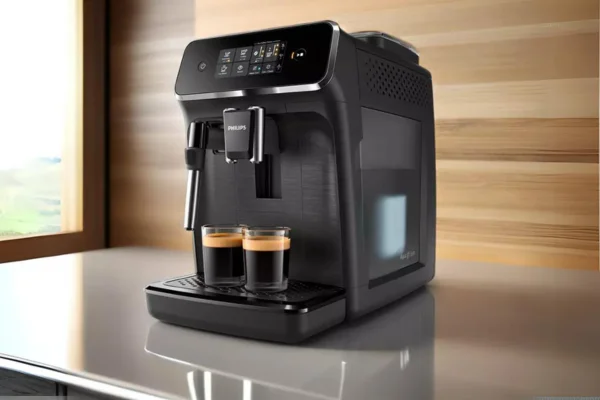
The Philips 2200 (EP2220/14) enriches your mornings by allowing you to make 2 specialty coffees in under a minute. You can make aromatic espressos and strong black coffee to kick-start your day. Or go a step further to froth milk with the Philips 2200’s stainless steam wand and make rich, creamy lattes. With the Philips 2200 Series espresso machine, you get freshly ground, delicious coffee at a single touch.
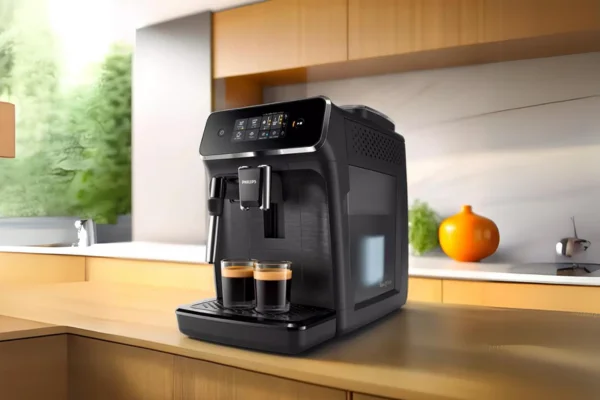
Philips 2200
Brew aromatic coffee with an intuitive touch display and customizable settings, ensuring perfect drinks every time.
Read Philips 2200 Full Review
REASONS TO BUY
- Fully automatic espresso machine
- Intuitive touch display
- 2 beverage options
- Easy to use and clean
- In-built coffee bean grinder
- Includes AquaClean water filter system
REASONS TO AVOID
- Limited options for specialty coffee
- Loud grinder
- Expensive
Philips 4300 Overview
The Philips 4300 Series also offers a range of fully automatic espresso machines, allowing you to choose between the classic milk frother and the LatteGo milk system. In the United States, the two most commonly available models for the Philips 4300 are EP4347/94 (includes the LatteGo milk carafe) and EP4321/54 (comes with the classic steam wand).
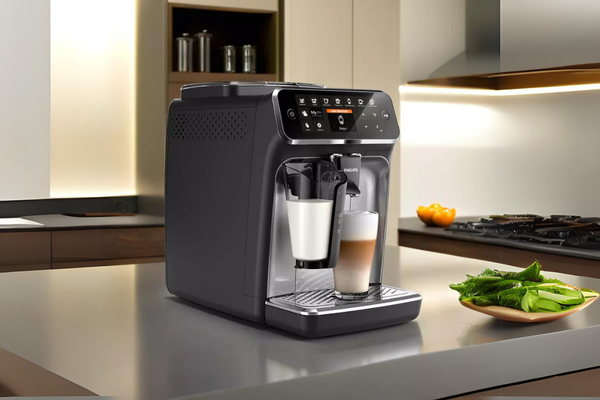
But for this Philips 2200 vs 4300 discourse, we will specifically evaluate the price, perks, and performance of the Philips 4300 – EP4347/94 as this model is comparatively easier to find at retailers like Amazon, Best Buy, Versuni, and Walmart for less than $1,000.
The Philips 4300 (EP4347/94) can turn your kitchen or office pantry into a boutique cafe with its 8 specialty coffee options. From espresso to Americano and Ristretto to cappuccino, you can get 8 delicious coffee varieties within seconds. Its innovative LatteGo milk frothing tech spins the perfect milk magic, ensuring you feel the velvety richness in every sip.
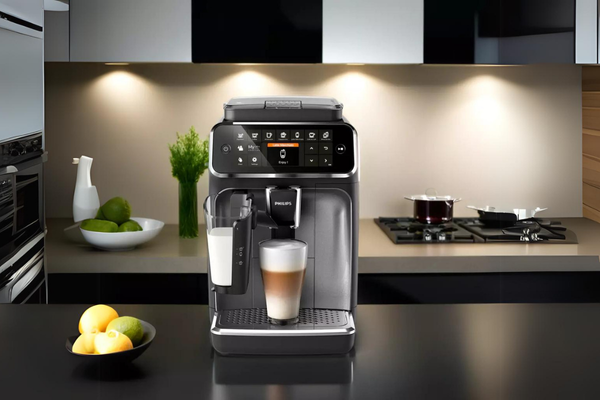
Philips 4300 LatteGo
Enjoy various drinks with a user-friendly interface, customizable strength settings, and easy maintenance with dishwasher-safe components.
Read Philips 4300 LatteGo Full Review
REASONS TO BUY
- Automated coffee machine
- User-friendly touch display
- 8 beverage options
- Advanced settings
- AquaClean water filter
- Under $1,000
REASONS TO AVOID
- The coffee grinder is loud
- Temperature and flavor of the coffee may vary
- Messy spouts
- An expensive option for basic coffee drinkers
Features and Specs Comparison – Philips 2200 vs 4300
In the following side-by-side comparison table, we have listed the technical specifications and features of Philips 2200 and 4300.
| Comparison | Philips 2200 | Philips 4300 Series |
|---|---|---|
| Type | Fully automatic | Fully automatic |
| Model No. | EP2220/14 | EP4347/94 |
| Retail Price | $649.99* | $999.00* |
| Dimensions | 246 x 371 x 433 mm | 246 x 371 x 433 mm |
| No. of Beverages | 2 | 8 |
| Grinder Settings | 12 | 12 |
| Temperature Settings | 3 | 3 |
| Water Tank Capacity | 1.8 litres | 1.8 litres |
| Coffee Bean Capacity | 275 grams | 275 grams |
| Material | Plastic | Plastic |
| Color | Matte Black | Black |
| Weight | 7.5 Kg | 8.25 Kg |
| Display | Touch screen | Touch screen |
| Filter Compatibility | AquaClean | AquaClean |
| Milk Solution | Classic milk frother | LatteGo |
| Power Consumption | 1500 W | 1500 W |
| Pump Pressure | 15 bar | 15 bar |
| Coffee Powder Option | Yes | Yes |
| Double Cap | Yes | Yes |
| Milk Double Cap | No | Yes |
| Removable Brew Group | Yes | Yes |
| Aroma Seal | Yes | Yes |
| Guided Descaling | Yes | Yes |
| Service Warranty | 2 years | 2 years |
| Consumer Rating | 4.4 out of 5 stars | 4.3 out of 5 stars |
Coffee Roast Level, Flavor and Grinding
From light-to-medium and medium-to-dark, you can experiment with every type of coffee roast to prepare beverages in Philips 2200 and 4300 espresso machines. Both options have an in-built ceramic burr grinder that promises more precision than blade grinders.
Its 12 advanced grinder settings allow you to choose between finely grounded coffee beans and a coarse blend, ensuring you get the desired taste and aroma each time.

And if you don’t like to start your mornings with the loud sound of grinding coffee beans, then you can use pre-ground coffee and add a few scoops to the small pre-ground coffee compartment next to the grinder.
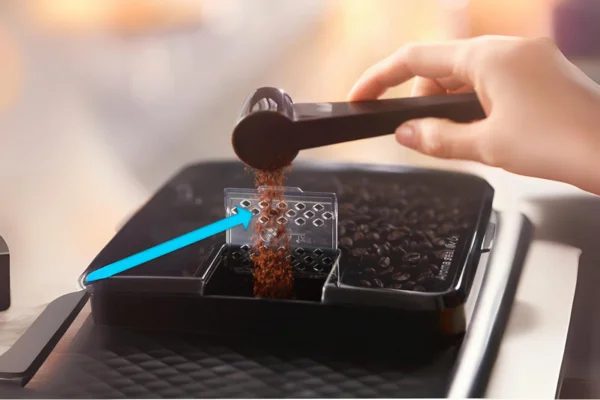
Take note that the grinder settings are adjustable with the twist of a knob. While some may find this feature easy to use, we believe it can mar the otherwise sleek look of the espresso machine.
Functions and Settings
The fundamental capabilities of Philips 2200 and 4300 are the same. You use the intuitive touch display to select your preferred beverage, adjust the coffee strength and temperature, and add milk if needed.
However, with the Philips 4300, you get never-before-seen advanced features like ‘Personal Profiles’ to store your preferred settings and the option to choose between 8 specialty coffees. The control panel has buttons for the following coffee varieties:
- Espresso
- Coffee
- Americano
- Cappuccino
- Latte Macchiato
- Café au lait
And more drinks, which include Caffé crema and Ristretto. You can touch the button to select any of the above cafe-quality coffee in the comfort of your home.

If you are the kind who loves the convenience of walking into your coffee shop and ordering “the usual”, then the Philips 4300 Personal Profiles feature is especially for you. You can create your profile and store the recipe through this feature. You may even use guest profiles for visitors to tweak the recipe to their liking.
But with the Philips 2200, none of this is possible. You only get 2 beverage options – espresso and ordinary coffee and the control panel only allows you to adjust the aroma strength and the quantity of coffee in each cup.

Milk Frothing
The Philips 2200 and 4300’s unique milk frothing systems can reduce bitterness and increase the rich, creamy sweetness of your hot beverages.
Philips 2200 includes a classic milk frother (a stainless steel steam wand) that jets pressurized steam into the milk, heating and frothing it to its soft, foamy texture. The wand is detachable and should be cleaned after each use to unblock the tip and steam valves.
The only downside to Philips 2200’s classic milk frother is that you will need a separate stainless steel pitcher to froth your milk because, when it comes to creating barista-style latte art, Philips 4300’s LatteGo tech cannot match the retro elegance of classic milk frothing.
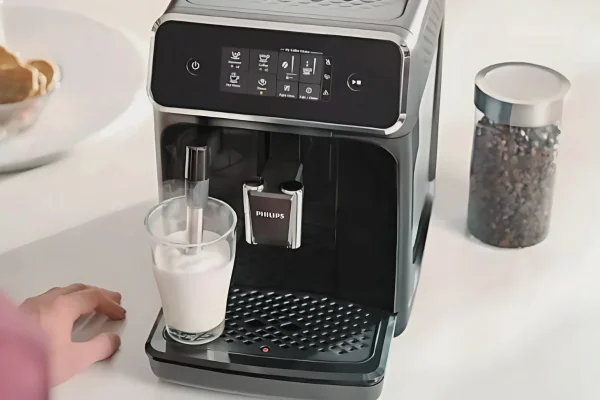
Philips 4300’s LatteGo technology is a new-age solution for frothing milk to the right temperature and consistency. Inside the carafe, the frother mixes milk, air, and steam at high speed to create foam, which then pours right out of a spout into your hot coffee cup.
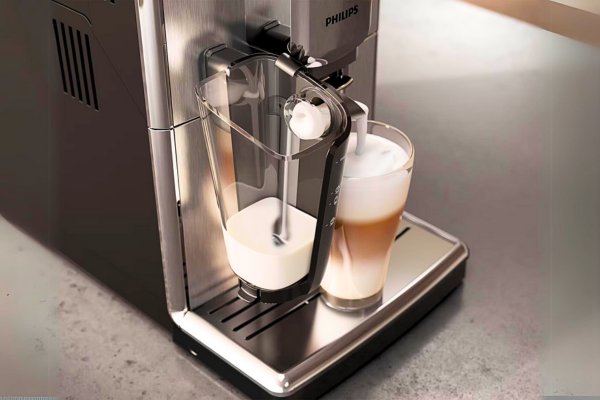
You can froth up to 260 milliliters of milk in the LatteGo carafe. However, users have complained that the spouts are messy, spilling most of the milk, and the plastic container’s durability is questionable.
Water Filter System
Philips 2200 and 4300 include the AquaClean water filter, which can purify water for up to 5,000 cups of coffee without descaling. You must install AquaClean in the espresso machine’s water tank and fill it to its maximum capacity (1.8 liters) for optimal use.
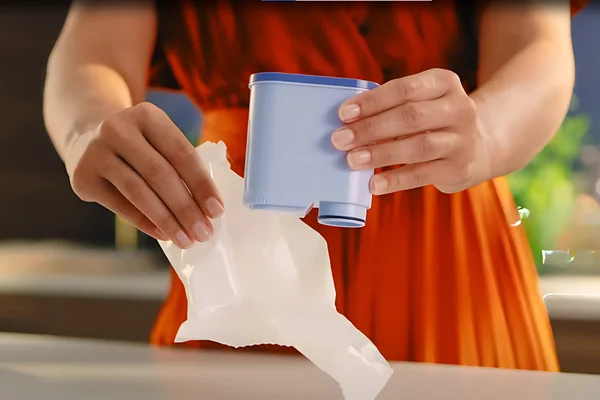
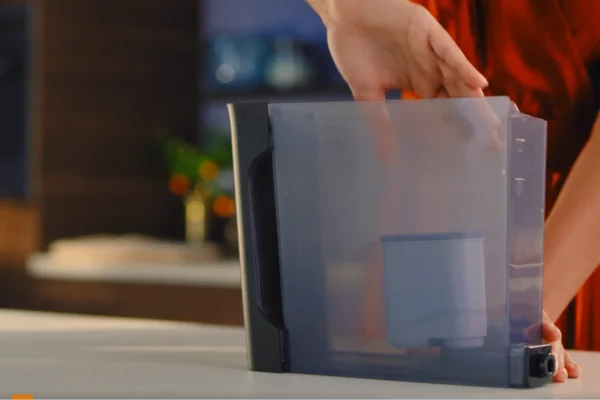
The AquaClean water filter absorbs impurities, like chlorine, and hard minerals, like calcium, magnesium, and lead, to adjust the water hardness level and prevent the formation of limescale in the coffee machine. It significantly improves the taste and quality of your coffee by ensuring a higher level of hygiene.
Power Consumption
Philips 2200 and 4300 use around 1,500 Watts of electricity to brew double cups of espresso in less than a minute. Most automatic coffee machines consume between 600 and 1,200 Watts.

So, Series 2200 and 4300 may not be ideal if you prioritize power conservation and cost-saving on your electricity bills.
Portability
Portability goes a long way. When choosing a superautomatic coffee machine for your home or office, you must be mindful of its design and portability. You may have to move the machine around for deep cleaning, home renovations, or relocating.
Luckily, both Philips 2200 and 4300 are considered portable espresso machines despite their range of in-built features. However, the Philips 2200 is more lightweight compared to the Philips 4300.
It weighs around 16.5 lbs (7.5 Kg), whereas Series 4300 weighs nearly 18.2 lbs (8.25 Kg). The difference in their respective weights is mainly due to the addition of a LatteGo milk carafe in the 4300 version.
Price and Warranty – Philips 2200 vs 4300
When it comes to the cost of Philips 2200 vs. 4300, we can confidently say that their prices reflect their value. The Philips 2200 is one of the most basic fully automatic expresso machines for everyday coffee drinkers. It costs around $650, and you may even be able to get it at a discount or in monthly installments at retailers like Walmart and Best Buy.
As for the Philips Series 4300, its high cost justifies its premium features. The official price tag of Philips 4300 is $999. Retailers like Best Buy and Walmart allow you to purchase it on month-to-month finance plans, starting as low as $46 per month, saving you from the hassle of forking out a grand in one shot.
Both Philips 2200 and 4300 come with a 2-year manufacturer warranty. So, if you encounter any trouble with its intelligent touch display or need a part repaired or replaced, you can contact your nearest Philips customer center and get that resolved for free.
Better Reviews and Ratings – Philips 2200 or 4300?
There is no doubt that the Philips 4300 is a favorite product among consumers. Its average rating is 4.46 out of 5 stars, and it is one of the most frequently bought coffee machines on top retail outlets like Amazon, Seattle Coffee Gear, and Best Buy.
On the Philips product page, Series 4300 is recommended by 93% of consumers, and many have praised it for its easy user interface, dishwasher-safe parts, coffee quality, and wide selection of specialty coffees.
In contrast, the Philips 2200’s average rating is 4.1 stars. Although this particular model is no longer being sold by top retailers like Seattle Coffee Gear, Best Buy, and Walmart, it is still an 86% consumer-recommended product on its official Philips page. Around 78 reviewers have given Series 2200 an accumulative 4.4-star rating and have lauded it for its sophistication, sleek design, convenience, and consistently good coffee.
The following table summarizes the customer ratings for Philips 2200 and 4300 on various platforms.
| Platform | Philips 2200 (EP2220/14) | Philips 4300 (EP4347/94) |
|---|---|---|
| Philips | 4.4 stars | 4.5 stars |
| Amazon | 3.8 stars | 4.3 stars |
| Seattle Coffee Gear | – | 5.0 stars |
| Best Buy | – | 4.6 stars |
| Walmart | – | 3.9 stars |
Final Verdict – Philips 2200 or 4300?
So, the Philips 2200 or 4300, which espresso machine will you choose? Still confused? Let’s break it down.
If budget is not an issue for you and you are willing to invest nearly $1,000 in a premium automatic espresso machine, then don’t let Series 4300 slip away.
As it is, its stock is limited in the USA, and shipping it from overseas could take months. With advanced features like ‘personal profiles’ and up to 8 coffee varieties, it truly has the power to turn your kitchen into a boutique coffee shop. But if you don’t want to splurge, then Series 2200 is a decent option.
You can also check out our Philips 2200 vs 5400 comparison blog to see what difference a $100 can bring to your coffee routine.

